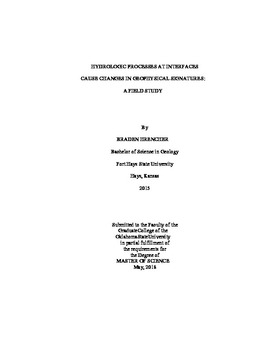| dc.contributor.advisor | Vilcaez, Javier | |
| dc.contributor.author | Hrencher, Braden | |
| dc.date.accessioned | 2019-05-08T18:36:53Z | |
| dc.date.available | 2019-05-08T18:36:53Z | |
| dc.date.issued | 2018-05-01 | |
| dc.identifier.uri | https://hdl.handle.net/11244/319630 | |
| dc.description.abstract | Enhanced biogeochemical activity resulting from the mixing of complementary terminal electron acceptors and electron donors characterize many classic transition environments. Few studies have been conducted to better understand the role that water oscillations or groundwater-surface water mixing have on the biogeochemistry and microbial composition. The need for imaging technologies that can identify biogeochemical hot zones in the subsurface and help guide microbial and geochemical sampling so that these zones can be better studied and understood is very important. In this study, the use of surface seismic methods in detecting the end product of biogeochemical processes driven by hydrologic processes is demonstrated using a hydrocarbon contaminated site in Bemidji, Minnesota as an example. The experiment uses the Multichannel Analysis of Surface Wave (MASW) method to analyze shear wave along two profiles. Results show a high shear wave velocity layer (>220 m/s) coincident with the water table oscillation zone. Environmental scanning electron microscope images integrated with core description and analysis, suggest the presence of biofilms may explain the higher shear wave velocity. This finding is consistent with other shear wave experiments, both in the lab and field setting. We confirm that the fluctuating water table drives the biogeochemical processes which in turn drive the geophysical changes recorded. Our results may be applicable to the remote detection of biogeochemical hot zones and can help guide geochemical and microbial sampling in these environments. | |
| dc.format | application/pdf | |
| dc.language | en_US | |
| dc.rights | Copyright is held by the author who has granted the Oklahoma State University Library the non-exclusive right to share this material in its institutional repository. Contact Digital Library Services at lib-dls@okstate.edu or 405-744-9161 for the permission policy on the use, reproduction or distribution of this material. | |
| dc.title | Hydrologic Processes at Interfaces Cause Changes in Geophysical Signatures: A Field Study | |
| dc.contributor.committeeMember | Atekwana, Estella A. | |
| dc.contributor.committeeMember | Ismail, Ahmed Mahmoud Ali | |
| osu.filename | Hrencher_okstate_0664M_15795.pdf | |
| osu.accesstype | Open Access | |
| dc.description.department | Geology | |
| dc.type.genre | Thesis | |
| dc.type.material | Text | |
